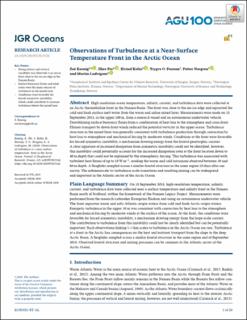| dc.contributor.author | Koenig, Zoé Charlotte | |
| dc.contributor.author | Fer, Ilker | |
| dc.contributor.author | Kolås, Eivind | |
| dc.contributor.author | Fossum, Trygve Olav | |
| dc.contributor.author | Norgren, Petter | |
| dc.contributor.author | Ludvigsen, Martin | |
| dc.date.accessioned | 2020-09-07T10:41:36Z | |
| dc.date.available | 2020-09-07T10:41:36Z | |
| dc.date.created | 2020-04-17T14:09:29Z | |
| dc.date.issued | 2020 | |
| dc.identifier.citation | Journal of Geophysical Research (JGR): Oceans. 2020, 125 (4), . | en_US |
| dc.identifier.issn | 2169-9275 | |
| dc.identifier.uri | https://hdl.handle.net/11250/2676632 | |
| dc.description.abstract | High‐resolution ocean temperature, salinity, current, and turbulence data were collected at an Arctic thermohaline front in the Nansen Basin. The front was close to the sea ice edge and separated the cold and fresh surface melt water from the warm and saline mixed layer. Measurements were made on 18 September 2018, in the upper 100 m, from a research vessel and an autonomous underwater vehicle. Destabilizing surface buoyancy fluxes from a combination of heat loss to the atmosphere and cross‐front Ekman transport by down‐front winds reduced the potential vorticity in the upper ocean. Turbulence structure in the mixed layer was generally consistent with turbulence production through convection by heat loss to atmosphere and mechanical forcing by moderate winds. Conditions at the front were favorable for forced symmetric instability, a mechanism drawing energy from the frontal geostrophic current. A clear signature of increased dissipation from symmetric instability could not be identified; however, this instability could potentially account for the increased dissipation rates at the front location down to 40 m depth that could not be explained by the atmospheric forcing. This turbulence was associated with turbulent heat fluxes of up to 10 W m−2, eroding the warm and cold intrusions observed between 30 and 60 m depth. A Seaglider sampled across a similar frontal structure in the same region 10 days after our survey. The submesoscale‐to‐turbulence‐scale transitions and resulting mixing can be widespread and important in the Atlantic sector of the Arctic Ocean. | en_US |
| dc.language.iso | eng | en_US |
| dc.publisher | American Geophysical Union | en_US |
| dc.rights | Navngivelse 4.0 Internasjonal | * |
| dc.rights.uri | http://creativecommons.org/licenses/by/4.0/deed.no | * |
| dc.title | Observations of Turbulence at a Near-Surface Temperature Front in the Arctic Ocean | en_US |
| dc.type | Peer reviewed | en_US |
| dc.type | Journal article | en_US |
| dc.description.version | publishedVersion | en_US |
| dc.subject.nsi | VDP::Oseanografi: 452 | en_US |
| dc.subject.nsi | VDP::Oceanography: 452 | en_US |
| dc.source.pagenumber | 20 | en_US |
| dc.source.volume | 125 | en_US |
| dc.source.journal | Journal of Geophysical Research (JGR): Oceans | en_US |
| dc.source.issue | 4 | en_US |
| dc.identifier.doi | 10.1029/2019JC015526 | |
| dc.identifier.cristin | 1806808 | |
| dc.relation.project | Norges forskningsråd: 276730 | en_US |
| dc.description.localcode | ©2020. The Authors. This is an open access article under the terms of the Creative Commons Attribution License, which permits use, distribution and reproduction in any medium, provided the original work is properly cited. | en_US |
| cristin.ispublished | true | |
| cristin.fulltext | original | |
| cristin.qualitycode | 2 | |

